You have already visited Cordoba on more than one occasion and you want to see new things
Get out of the city or rummage through its narrow streets… discover something different, lesser-known corners. In this post we are going to help you by recommending 10 charming and less frequented places or activities. Sometimes they are far away, sometimes in the centre itself. And what they all have in common is that they are wonderful places in authentic Cordoba.
We know all these places, some of them we have visited several times, so we recommend them as something personal. If you prefer to see the 10 best rated places in Cordoba follow the link. We also recommend our experiences in Cordoba to get to know the city in small groups.
What you will find here
Patios, grilles and plants
One of the greatest charms of Cordoba is its popular houses. The Patio is the distribution centre of the different residences or rooms. Observe its grilles and windows, its vestibules, the colour of its interior gardens. If you go during the Patios de Córdoba festival, you will see a somewhat crowded atmosphere. Forget about listening to the silence, which is only interrupted by a small stream of water flowing from the pillars. Some locals keep their courtyards open all year round, so we recommend you visit them before or after the festivities. The maintenance of these places is carried out by the locals themselves almost single-handedly. They are responsible for creating a unique spectacle for the enjoyment of locals and visitors alike. The friendliness of the people of Cordoba is a common occurrence, it is not difficult to strike up a good conversation about their homes.
Do you want to know where are all the courtyards of Cordoba?
IMPORTANT NOTE: you have to get lost in the narrow streets and discover the patios between the half-open doors. But be careful, most of them are private spaces, you have to measure the volume of your words and of course, do not interrupt the life of the neighbours. There are no rules to follow, just be empathetic.
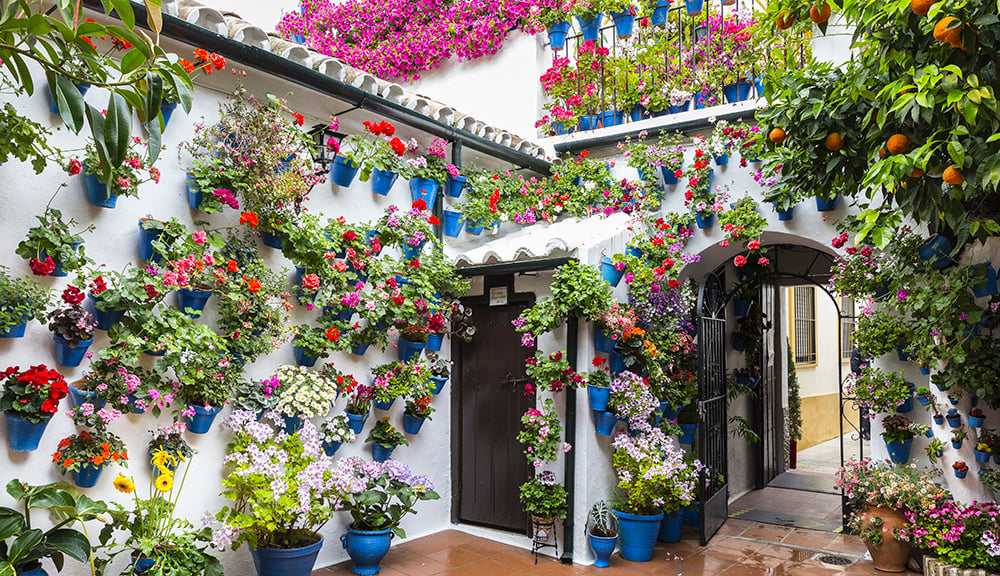
Patio of Cordoba dressed with flowers. One of the most used flowers is the geranium with its many colour variations.
La Calleja de la Hoguera
The narrowness, the bends and the passages are some of the elements reminiscent of Andalusian urban planning. The Calleja de la Hoguera leads to the Mezquita de los Andaluces, a 12th century Almohad temple that is well worth a visit. Walking along the street between its high whitewashed walls will take you back to another time. It is undoubtedly a beautiful example of an Andalusian “calleja”. Although today the street has an exit, in the past it was a azucaque or adarve, a dead-end street that used to connect several houses linked by kinship. It is undoubtedly one of the streets we pass through on our private tours of Cordoba.
In Cordoba there are many charming streets waiting for you.
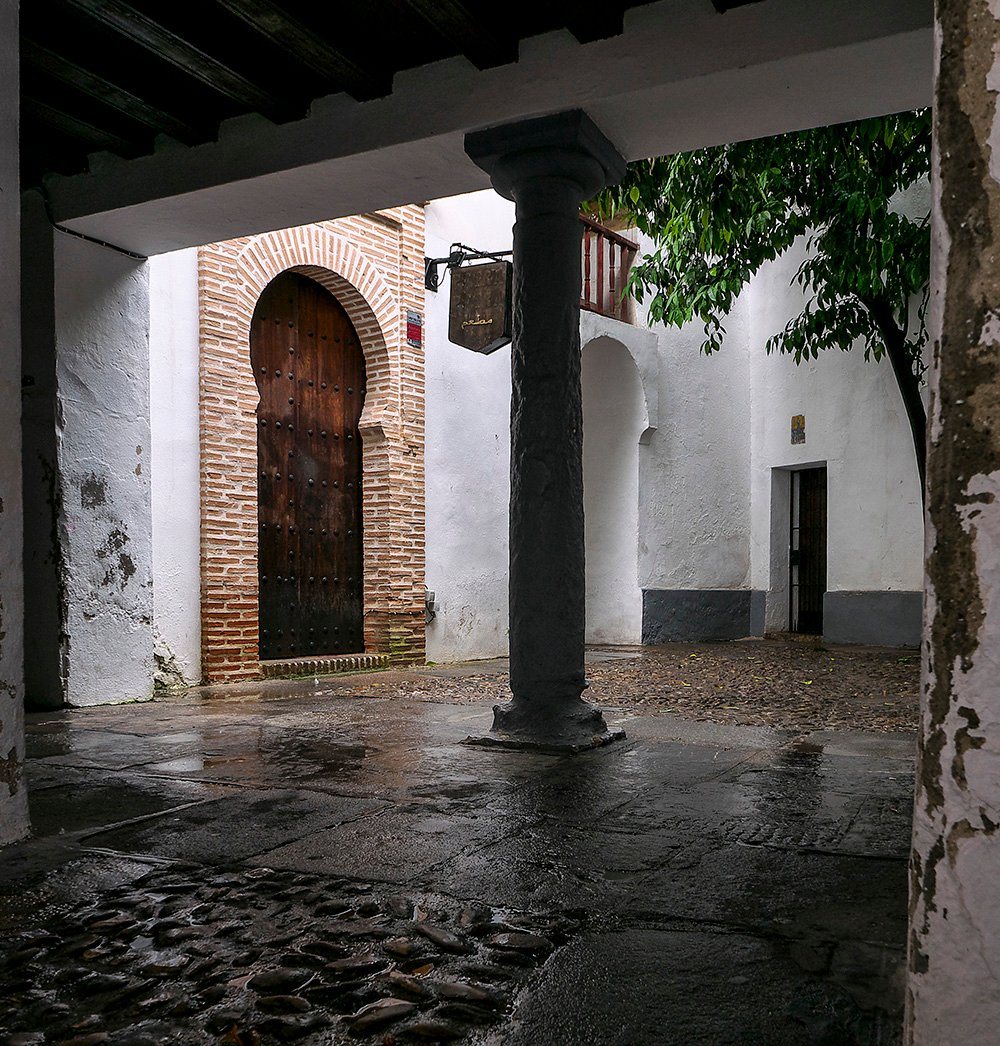
Calleja de la Hoguera after the rain (José Luis Filpo Cabana. Wikicommons. CC BY 4.0).
Plaza de los Capuchinos
It’s a well-known place, we won’t tell you anything about it, but it’s still very charming. In the centre of this small square is the Cristo de los Desagravios y Misericordia. It is surrounded by 8 lanterns, which is why it is better known as the Christ of the Lanterns. The square is flanked by Christian buildings that have hardly changed since the 18th century. When to visit this square? When the sun has gone down, but there is still light in the sky and the lanterns are lit. The combination of the dark blue sky and the incandescent warmth of the electric light is an ideal combination.
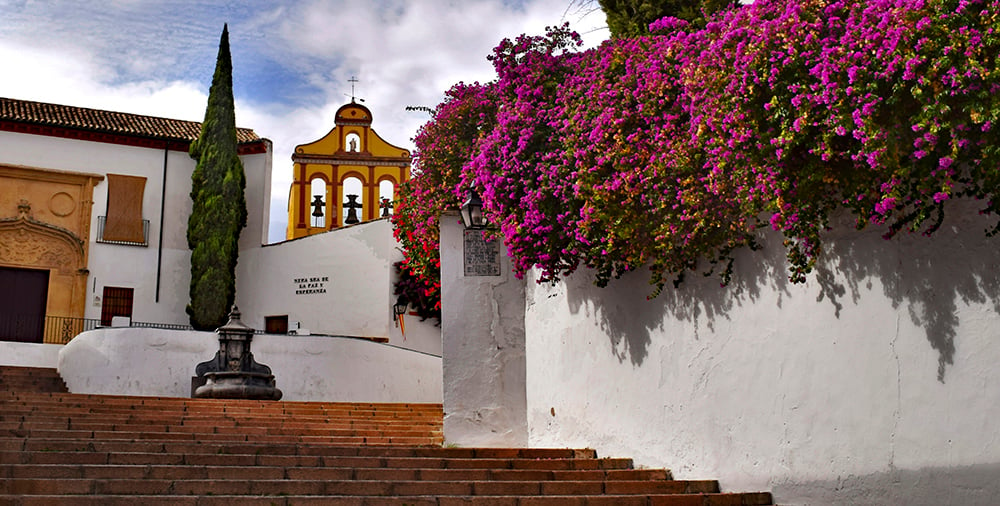
Plaza de los Capuchinos (Jocelyn Erskine Kellie. Flickr. CC BY 2.0).
La Plaza de la Corredera
This is a main square in the Spanish baroque style (very similar to those in Salamanca and Madrid). This is the only square of its kind to be built in Andalusia. It was the nerve centre of commerce in Cordoba. In the 19th century the old market or market square was built. In the 1950s the old market was demolished and a new one was built underground. During its construction roman mosaics belonging to a villa on the outskirts of the city were found. To see these mosaics you must visit the Alcázar de los Reyes Cristianos.
Its name, from the sliding gate, comes from before the square was even built. The first bullfight was documented in 1513. This celebration continued until the 19th century. This is the end of our night tour of Cordoba.
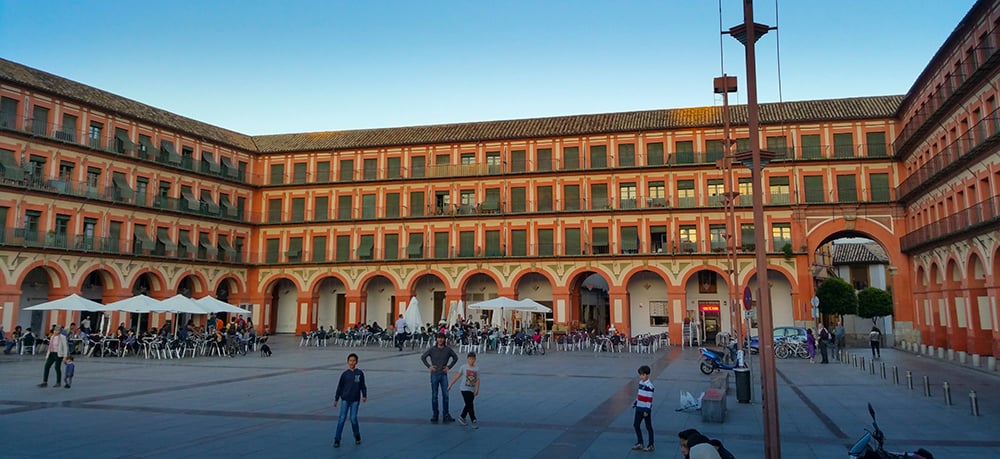
Plaza Mayor de La Corredera. A space full of life in the centre of Cordoba.
A SHORT BREAK FROM READING
If you are planning to visit Cordoba you have to know these guided tours
Taberna de San Miguel, “Casa el Pisto”
This tavern with a lot of charm is a meeting place for many people from Cordoba. It was founded in 1880 and since then has been linked to bullfighting life. It preserves the flavours of yesteryear and is a good representative of Cordoba’s culinary tradition. Its walls are full of paintings and photographs of illustrious figures, reminders of the history of the place. Music has always been present in its rooms, spaces that have been shared by ordinary people and famous personalities. In the 21st century, the tavern has received several awards for its excellent gastronomy, which only adds to its legend.
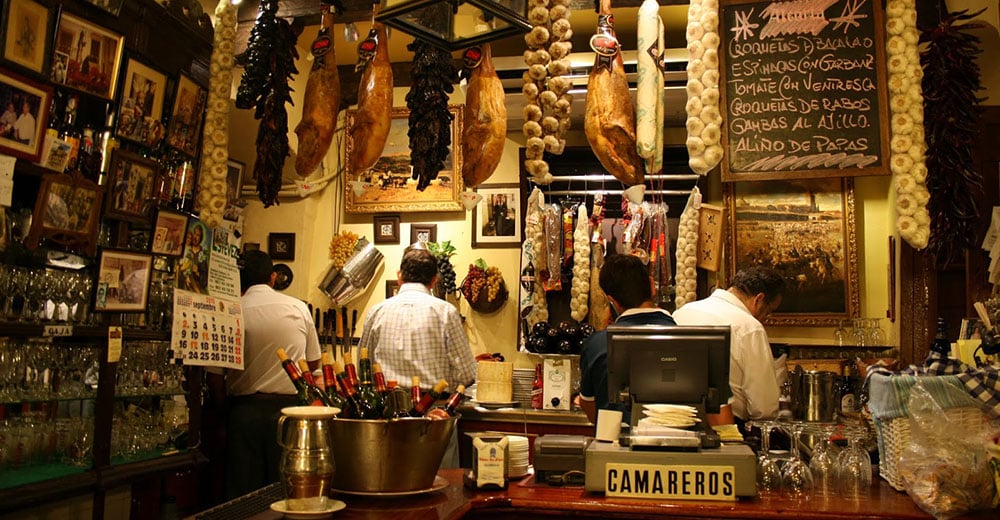
The flavour of Andalusia is preserved in old taverns like “Casa del Pisto” in Cordoba.
The Municipal Souk
The Municipal Souk of Cordoba is a project from the 1950s which aimed to recover the crafts of the city. In this souk you will find workshops with craftsmen who work manually with leather, wood and some metals such as silver. You will be able to see live what each of these works consist of and buy 100% handmade products, without intermediaries and at a fair price.
Moreover, this craft centre is located in a space of narrow streets, passageways and courtyards annexed to the Casa de las Bulas. It is dominated by dim lighting, flower pots on the walls and water pillars. In the surrounding area you can also visit the Maimonides memorial and the Bullfighting Museum.
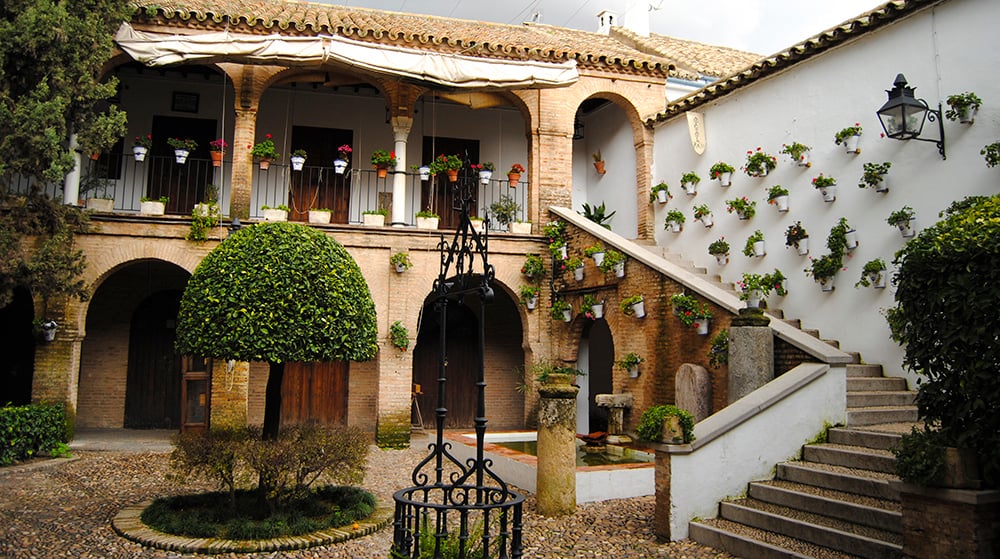
Plaza del Zoco Municipal de Córdoba. Space for handicrafts in the middle of the Jewish quarter (Plaza del Zoco Municipal de Córdoba. CC BY-SA 3.0).
A Medina al-Zahara without a motor
It is possible to go by foot or bicycle to Medina al-Zahara. Between the outward and return journey there is a distance of approximately 16 km and the cumulative difference in altitude does not exceed 110m. It is an accessible route for those who are used to walking and are looking for something different. The first and autumn months are the most suitable for this walk due to the mild temperatures. The route runs between the Guadalquivir River and the first foothills of the Sierra Morena. During the months of May, June and July it is occupied by summer sunflowers. In the months of September and October cotton will be the protagonist.
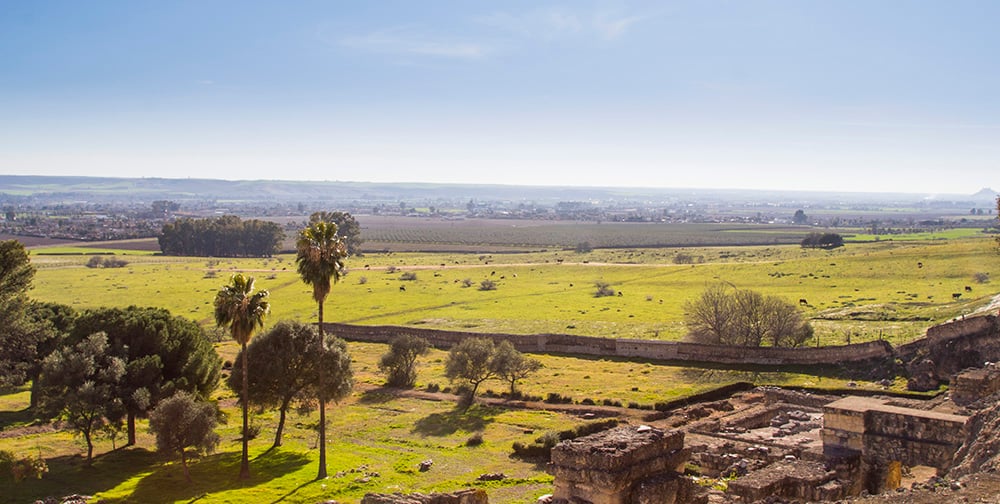
View of Cordoba from Medina al-Zahara. Flat roads between pastures and crops.
Plaza del Potro
This small and welcoming square is perhaps one of the most beautiful in Andalusia. In this place it seems that time has not passed, both the buildings and the pavement of large stone slabs keep the square as it was. On one of its sides you will find a fountain crowned by a small sculpture of a colt with the city’s coat of arms, hence the name of the square.
It is also a space for cultural dissemination. The Museo de Bellas Artes de Córdoba and the Museo Julio Romero de Torres overlook the square. The Posada del Potro can also be accessed from the square. It is a 15th century dwelling mentioned in Cervantes’ El Quijote. It is currently the Casa del Flamenco in Cordoba.
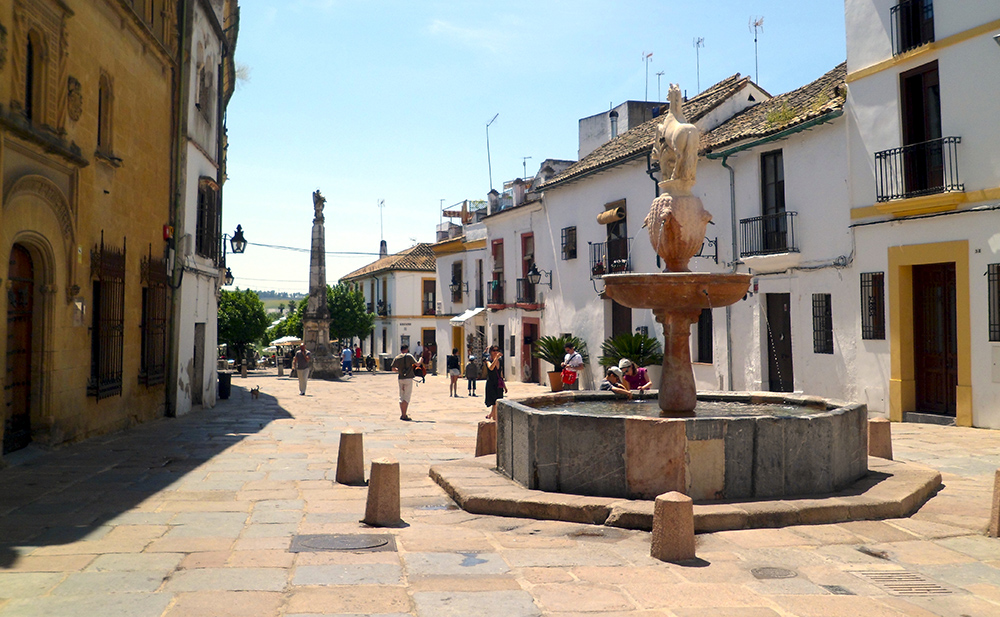
Plaza and fountain of El Potro. A space full of history and museums (Américo Toledano. Wikicommons. CC BY-SA 3.0)
Plaza de Jerónimo Páez
They say that in this quiet square a tragic story took place, from which the Pero Mato was composed. A story of love, envy and honour or, as we would call it today, gender-based violence. The story must have dismayed the city of Cordoba and today it has come down to us as a legend that some people doubt.
Apart from this story, this peaceful square with its irregular floor plan is an ideal place to rest. To continue, in the Renaissance palace of los Páez is the Museo Arqueológico y Etnológico de Córdoba. The singularity of this museum is that among its rooms you can visit the Roman theatre of the city.
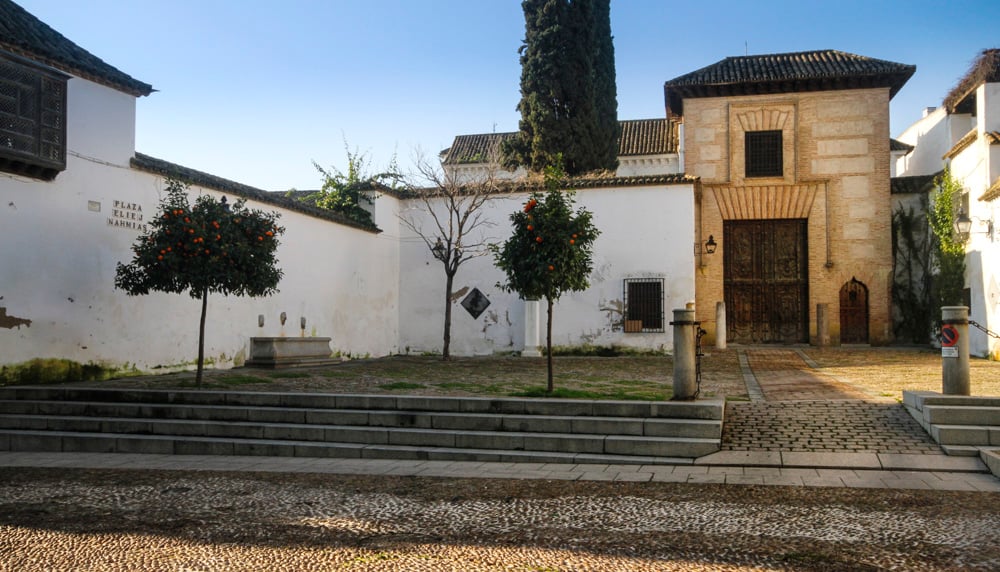
Vegetation, water, whitewashed walls and history in the Plaza de Jerónimo Páez (José Luiz Bernardes Ribeiro. WikiCommons. CC BY-SA 3.0).
Alminar de San Juan
Minaret or minaret from which the faithful were called to prayer. Today it is called San Juan because the mosque to which it belonged was ceded to the Order of San Juan after the Reconquest. This Christian order built a church in accordance with their religious habits and transformed the minaret into a bell tower. This is very common in Andalusia, and many towns still have Andalusian minarets. The minaret of San Juan has the usual square ground plan and is built with string-and-tenon ashlars. This is a building technique used in the Caliphate period, which points to its construction between the AH 9th and 10th centuries.

Alminar de San Juan de los Caballeros (Jose Luis Filpo Cabana. Wikicommons. CC BY 3.0).
At Andalucía 360 we are more into getting lost in places in search of that magical moment when you get to feel part of what you are visiting. So we hope you enjoy this list and that you can add to it with your own discoveries. And if you want to send us suggestions they are always welcome.
Looking for accommodation in Cordoba?
Compare and find your perfect accommodation at trivago.co.uk.
MAP OF CORDOBA WITH CHARM
As always, in the map we show you the location of the places to see in Cordoba described in this post.

